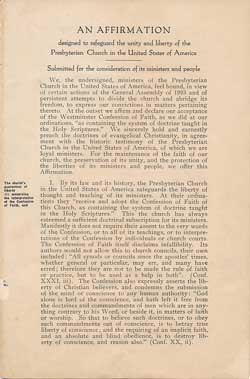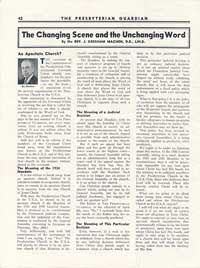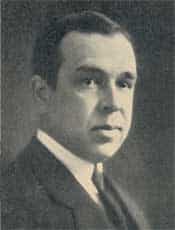Working through some pamphlets and other materials donated by Dr. Will Barker, I came across this little tract, which may be of interest. It is a reprint of an article that first appeared in THE PRESBYTERIAN JOURNAL, on 30 January 1963. Irrespective of the calendar date, this remains very much in the news these days:
ACADEMIC FREEDOM
Examining the idea that teachers are above the rules
ordinary mortals go by—
by G. Aiken Taylor, Ph.D.
 The issue of “academic freedom” is rapidly becoming a major one. In some denominations there is no greater. A poll of 30 Baptist editors—for instance—placed the dismissal of Dr. Ralph Elliott from Midwestern Baptist Seminary, and the appointment of a special committee by the 1962 Southern Baptist Convention to re-study its statement of faith, as the two top news stories of 1962. Both stories had to do with the issue of academic freedom.
The issue of “academic freedom” is rapidly becoming a major one. In some denominations there is no greater. A poll of 30 Baptist editors—for instance—placed the dismissal of Dr. Ralph Elliott from Midwestern Baptist Seminary, and the appointment of a special committee by the 1962 Southern Baptist Convention to re-study its statement of faith, as the two top news stories of 1962. Both stories had to do with the issue of academic freedom.
Dr. Elliott was dismissed from the seminary on account of his book, The Message of Genesis, which allegedly treats Biblical history lightly. His dismissal was hailed as a victory by conservative forces in the never-ending struggle between liberal and conservative elements which is going on in all Churches today.
Unfortunately, the outcome of the incident is not yet clear. Although the action against Dr. Elliott was supported by most state conventions we heard from, the liberals—mostly the academic community in this case—have shown no intention of letting it go at that. While the conservatives rest on their oars, confident in victory, the campaign to discredit them gradually increases in vigor and will probably win out in the end.
Conservatives are notoriously like the hare in the fable of the tortoise and the hare. They get excited but tend to relax again just as easily. The liberals, on the other hand, patiently keep up their subtle pressures until the resistance is overcome.
Latest development in the Elliott case is a paper signed by 37 religious professors in eight Southern Baptist colleges, condemning the seminary for “sacrificing” its “integrity in Biblical scholarship” and “denying” the “seminary’s freedom to interpret Scripture under the authority of Christ in Scripture” (which usually means, “the right to teach students to mistrust people who take the Bible to mean what it says.”)
We can predict the outcome of this controversy with a fair degree of assurance. Dr. Elliott will be reinstated—or elevated to something better—the book will be brought out by another publisher and will become an approved text in schools and colleges. The whole Baptist denomination, which supported his dismissal, but which ran out of steam as soon as he had left the seminary, will stand by helplessly wringing its collective hands.
A SECULAR EXAMPLE
Down in Florida another example of controversy over academic freedom has been unfolding, this time in the world of secular education. The whole state has been in an uproar over something which developed at the University of South Florida, in Tampa, where the atmosphere in some classes was alleged to have attained almost incredible depths of depravity and irreverence. One professor was dismissed. A legislative investigation of the whole state university system was held, resulting in some new statements of policy by the Board of Control. But after the dust had settled the professor was reinstated and business has continued pretty much as usual in Florida.
In the world of religion the issue of academic freedom appears as “freedom of conscience” or “freedom to interpret the Scriptures according to conscience.” The intensity of concern which some feel is reflected in that “message” recently issued by the Division of Higher Education of the Presbyterian Church US wherein it was urged that “the whole enterprise of higher education should be free from social, political, ecclesiastical and economic reprisals against academic freedom.”
The issue also rears its head in such controversies as that one which attended the Fifth World Order Study Conference of the National Council of Churches with its famous recommendation that Red China be admitted to the United Nations (“The Conference certainly had a right to speak its mind to the Churches”); and the Winston-Salem General Assembly hassle over the Layman’s Bible Commentary (“Writers have a right to follow the leading of responsible scholarship”).
What about it? The governor of Florida, at the height of the controversy in that state, offered some informal remarks at a news conference which constitute a sort of classic answer to the labored quibbles of those liberals who really want license to subvert when they demand “freedom.” Said the governor:
“Academic freedom is, of course, a part of freedom. It doesn’t rise to any higher levels or sink to any lower depths than other elements of freedom. It is like freedom of the press—it is bound by certain limitations. It’s necessary—and with it go certain privileges and certain responsibilities . . . (there is) a distinction between academic freedom and academic license . . . Obviously, unless each man is to be a law unto himself, there must be someone to say what the law is relative to that man; or somebody, or some means . . .
“I am concerned, on the one hand, that we do nothing to limit a proper exercise of academic freedom. On the other hand, I am equally concerned that we do nothing to restrict the power of the people to express themselves in all areas of government. And there is no area excluded.
“The people have a right to restrict the governor — they do so. They have a right to restrict the courts—I think—historically they have done so. And I think they have a right to restrict the Legislature, and they do so. And therefore I don’t want to see us get ourselves in a situation where we set one group aside and say: ‘But you are a law unto yourselves.’ I don’t think it is enough to say: ‘Well, we are gentlemen and we are patriots and we are intellectuals, and therefore we do not need to be restrained at all,’ because in an ordered society there must be restraints on everyone, or else there is no law and if there is no law there is nothing to protect academic freedom or any other freedom. . .” The governor was speaking about the “right” of professors in a state university to teach atheism and to bring open obscenity and pornography into their classes. His remarks apply equally well to the “right” of professors of Bible and religion to teach anything they please about Bible and religion.
NO LIMITS TO ‘FREEDOM’?
We know one professor of Bible in a Presbyterian college who interprets the “freedom to interpret Scripture according to conscience” to mean that he is free to teach his students that the Bible is an utterly relative book, that even the Ten Commandments have no lasting validity. This professor caused a great uproar in a US synod last year. Then the uproar died down and he is still doing business at the same stand. But does “academic freedom” give him the right to teach in a Presbyterian institution that the Bible is not to be considered a final authority even in matters of religion?
In the case of Dr. Elliott our Baptist brethren have been concerned that professors in their institutions shall teach accepted Baptist interpretations of the Bible. Has the denomination the right to expect this?
May a man accept ordination in a Baptist church and then proceed to teach and practice Infant Baptism? Has he the right to accept a teaching position in a Baptist seminary and teach his students that without the episcopate and apostolic succession there can be no true Church?
What if a theologian in a Methodist institution tried to inculcate his students in Double Predestination? Or a Presbyterian professor began advocating prayers on behalf of the dead? Would such departures from denominational doctrine be right?
What of the Presbyterian who vows that he accepts the Confession of Faith, then manages to make it appear ridiculous every time he mentions it?
What of the teacher who denies the Virgin Birth or the substitutionary atonement of Jesus Christ? Has he the right in the name of academic freedom?
In other words, at what point does academic “freedom” cross the line of propriety and become irresponsible license? And who is to determine that point? The teacher himself?
It is quite possible that Presbyterian Church courts—presbytery, synod and General Assembly—have been hypnotized by the ecclesiastical eggheads waving that club of academic freedom. If so, one or two considerations may help bring things back into proper focus:
FREE TO SEARCH, BUT NOT TO CORRUPT
For one thing, a distinction should be made between the freedom to inquire and the freedom to teach. The human spirit may certainly roam freely in its search for truth but that freedom to roam is not to be equated with any alleged right on the part of one spirit to drag another spirit along with it on an excursion into error.
A science professor invites his students to enter the laboratory and by means of experiments find out for themselves what is true in the fields of physics, chemistry and biology. And when the student curiously begins to mix certain chemicals to see what will happen he is exercising a very necessary “freedom” to inquire and discover.
But the teacher who stands by encouraging this “freedom” on the part of his students has no right to tell them that if they mix chemicals “A” and “B” something predictable will happen—if he doesn’t really know what will happen by mixing chemicals “A” and “B”.
In like manner, the teacher of Bible or of religion may certainly encourage his students to pursue after truth with an unfettered spirit. But it can be said on the highest possible authority that no teacher of Bible or of religion has the slightest freedom to teach uncertain conclusions for truth.
Obviously, then, the question prior to that of academic freedom is the oldest of them all : What is truth?
If it be accepted as an axiom that one may not deliberately inculcate error or false conclusions—not even in the name of academic freedom—then it becomes important to determine how one arrives at the truth.
The freedom every spirit has to search for himself means that every spirit may determine what is true for himself, if he wishes. But every other man also has the right to determine what is true for himself. Does this mean that there will be as many different varieties of truth as there are men? Possibly—if every man is the sole judge of what is true.
But an infinite variety of opinions as to the truth of things would lead only to social chaos. Consequently men persuade each other to accept specific definitions of truth and they band themselves together on the basis of their agreement upon the truth.
This principle applies to religion.
Moreover the Christian religion begins by affirming that this truth has not simply been determined by some men and agreed upon by others, it is from God. This is where revelation comes in. And the Scriptures. And confessions of faith. And confessional bodies that hold to specific confessions of faith.
Christian people band themselves together on the basis of their agreement as to the nature of the truth of God. Confessional Churches, especially, are founded upon specific statements of faith upon which their members are bound to agree. Within the areas of agreement other areas of freedom may be agreed upon. But the very nature of the confessional Church means that the whole Church agrees to the limits both of the restrictions and of the freedoms. There is no such thing as being (honestly) a member of a confessional Church and believing as one pleases. One may try to influence changes in the bases of agreement but one may not conscientiously violate them. That is what Church vows are for.
Any member of a confessional Church who does not subscribe to the agreement as to the nature of truth upon which the Church is established, or who teaches others to have disrespect for the Church’s Confession—as is done in some Presbyterian circles—is a person with little honor: in the words of the Scripture, worse than an infidel.
[Reprinted from THE PRESBYTERIAN JOURNAL, January 30, 1963.]


 The document known as the
The document known as the 
